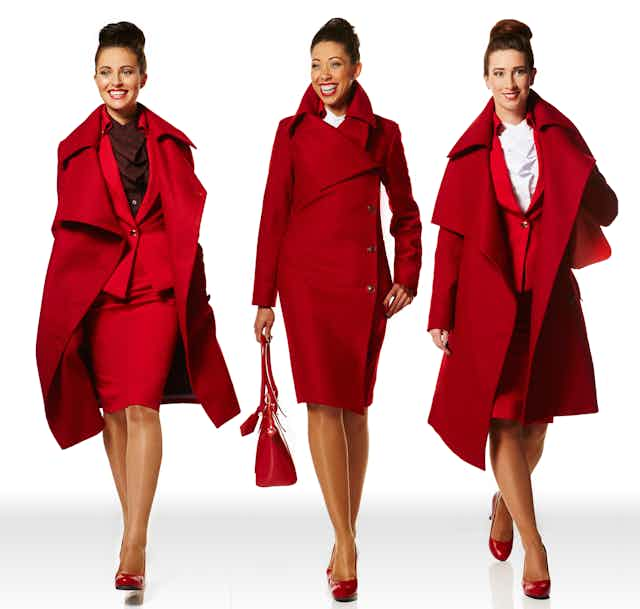Vivienne Westwood has launched new uniform designs for Virgin Atlantic. It’s sure to test whether the airline can remain competitive whilst crafting a progressive image: there’s a fine line between style and sex when it comes to airline uniforms. And in the wake of the recent Virgin blouse wars, which saw female staff on Virgin trains rejecting their new uniform as it included a flimsy and revealing blouse, Virgin have a lot to prove.
Let me give this a bit of context. Fashion was not a concern when the first “air stewardesses” started in the 1930s. They were trained nurses, recruited to reassure nervous passengers, at a time when safety was the primary concern.
But post-war prosperity altered the image of female in-flight staff, and the attributes of the flight attendant started to blend with that of the waitress, even the model. The image of the air hostess as a glamorous figure was starting to form.
By the time the “hostessing” image really came into its own in the 60s, airlines were clearly exploiting female staff for their sex appeal. Fashion designers began to be employed to spruce up their image. To signify stability and continuity, uniforms retained links with the past, but the fashion treatment kept staff attire up to date.
This resulted in staples like the air force-inspired pillbox hats, neck scarves and tailored jackets. Pierre Balmain designed a uniform for TWA and Pierre Cardin for Pakistan International Airways. But at this point the brief still dictated some form of military or naval styling, regardless of whether designers wanted to sex up the uniforms.

In the 1970s however, the Texan Southwest Airlines veered away from this. Their uniform for female staff consisted of orange hot pants worn with wide white belts, brass eyelets, and white boots with side lacing, freely admitting that “sex sells seats”.
In the 1990s, Easyjet cut to the chase by dressing their female cabin crew in casual black jeans and orange polo shirts, bearing the slogan “I’m an easy crew member”. And that decade also saw increased industrial unrest, with female workers challenging sector practices that exploited stereotypically feminine attributes. Sarah Finke of the International Transport Workers Federation (ITF) recalls their 1990s campaign against airline sexism, and explains why they wanted to focus on uniforms:
Tight uniforms undermine the cabin crew’s role as safety professionals who need to have the authority and respect of passengers in an emergency situation. At the same time, we were getting a lot of complaints about physical assault and harassment of female cabin crew.
Recent reports suggest that in-flight harassment is still an industry problem. Airlines are happy to package their female crew in restrictive and demeaning uniforms, even if it has a negative impact on airline safety and crew wellbeing. In 2012, Ryanair were rapped by a watchdog for a sexist advertising campaign depicting scantily clad models with the strapline “Red Hot Fares & Crew”. The budget airline has repeatedly ignored criticisms for issuing an annual “Girls of Ryanair” calendar, in which female staff take off their uniforms to pose in bikinis.

The Singapore Girl, a successful marketing concept for Singapore Airlines since 1972, reveals how central the female body has become to branding airlines. The aviation industry is highly competitive, and still uses images of women to sell seats.
But uniforms can leave female workers open to exploitation by their employers, and in turn airline passengers. Cathay Pacific female staff, for example, are among the latest to complain that too-tight skirts and short blouses were making them vulnerable to sexual harassment.
Many employers think the demand for aesthetic labour is entirely reasonable, that sexy uniforms and other enforced dress codes are only there to project a corporate image. Nobody wants to be accused of blatant sexual exploitation; yet when airlines design new uniforms they invariably return to the hey-day of air travel for inspiration.
So the Branson-Westwood partnership is far more interesting than perhaps first appears. It enters a debate that has been building for decades.

Westwood’s new uniform design for Virgin retains the iconic red for female cabin crew, this time a tailored suit with a touch of retro-futurist styling. She has never regarded herself a feminist, but Westwood’s clothes for women are bold, artful and sexually liberating. A figure-hugging suit with a classic cut, the new uniform is feminine, but strong and humourous; not trivial. Think Lady Penelope from Thunderbirds, an adventurous woman, icily indifferent to the sexism that surrounds her.
Westwood is an inspired choice; for one, Branson gets to share in her non-conformism and glow in the virtues of sustainability, working with a designer who, as he says, “believe(s) in challenging the status quo”. The reality is that Westwood’s punk fashion back-story is the ideal antidote to a tyrannical culture of enforced dress codes.
Virgin Airlines are making efforts to distance themselves from the toxic sexism of the aviation industry. Her design talent is considerable, but Westwood’s real value to Virgin is her brand, an obscure version of female empowerment and a mildly subversive reputation, a fudge to the grubby politics of aesthetic labour.

